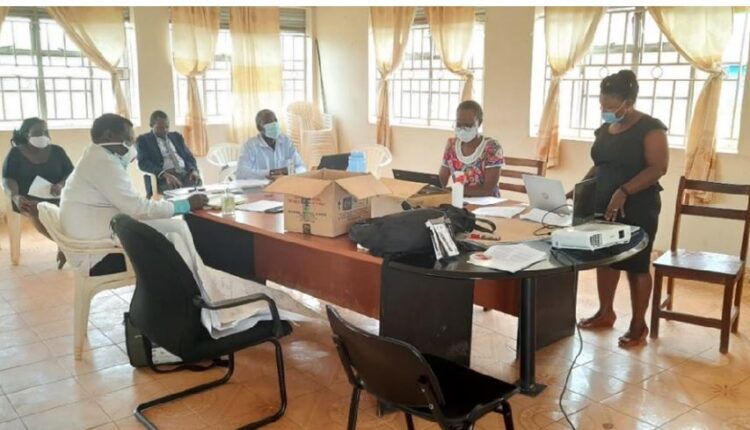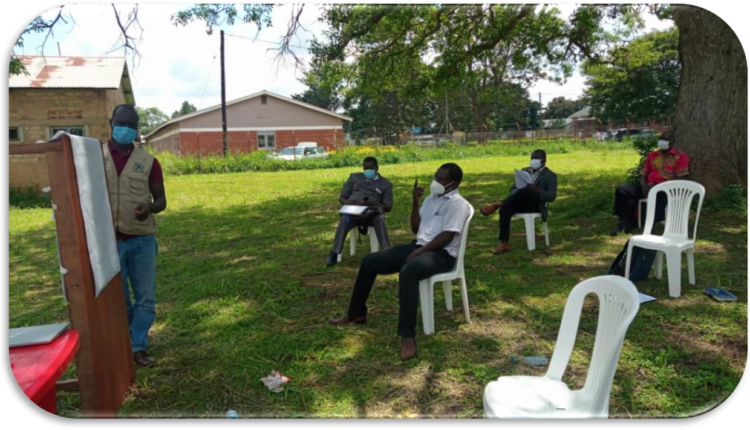The Uganda Public Health Fellowship Program Trains District Health Teams in five Districts of Lango on Early Detection of Malaria Outbreaks, September 2020
Quarterly Epidemiological Bulletin: October– December, 2020 Volume 5 / Issue 4 /Article No. 7 Authors: Job Morukileng1, Namayanja Josephine1 Alex Ndyabakira1 and Alex Riolexus Ario1 1Uganda Public Health Fellowship Program, Kampala, Uganda
Background
Malaria remains a major public health problem and the most frequently reported disease at both public and private health facilities in Uganda. The disease accounts for 30-50% of outpatient visits, 15-20% of admissions, and up to 20% of all facility deaths [1,2].
In 2019, there was a malaria upsurge in some of the districts in Uganda. These upsurges were detected late due to failure to analyze surveillance data both at the district and national level. The District Health Team (DHT) is responsible for monitoring malaria data collection, analysisis, and reporting in the district.
The World Health Organisation recommends plotting a malaria normal channel in malaria endemic countries including Uganda as a method for detecting outbreaks. Malaria normal channel refers to the normal seasonal pattern of malaria in an area [3], beyond which, an outbreak of malaria is detected. We trained DHT members on how to plot and interpret malaria normal channel graphs to facilitate early detection and response to malaria outbreaks.
Methods
We selected districts that registered upsurges of malaria case patients in 2019 (outbreak period) for immediate training on development of malaria normal channels. In Lango sub-region, we selected five districts including; Kole, Apac, Oyam, Alebtong, and Dokolo all located in in Northern Uganda.
We targeted a team of 50 participants, 10 participants per district, and the participant categories included: the DHO, malaria focal person, Health Management Information System (HMIS) focal person, District Biostatistician, District Surveillance Focal Person (DSFP), Assistant-DHO Maternal Child Health, Assistant-DHO Environmental Health, plus 3 other participants selected by the district (for example, representatives from main hospital or health sub-district).
We used a case study developed by Uganda Public Health Fellowship Program in 2019 (Analysis of malaria surveillance data (2014-2019) to train the DHTs to draw and interpret a malaria normal channel. The case study initial session recaps the participants on the general knowledge on surveillance, its importance, the different types of surveillance and advantages and disadvantages of each type, followed by the step by step hands on instructions on how to construct the malaria normal channel graphs.
We trained participants on two main methods of plotting malaria normal channels, that is, mean and two standard deviations (2SD) method and percentile method. Participants used computers/laptops and graph papers to construct malaria normal channels and were guided on how to interpret them.
Achievements
Of the targeted 50 participants, we trained 40 (80%) DHT members from five districts of Kole, Apac, Oyam, Alebtong, and Dokolo in five days, one day training per district (Table 2).
Table 2: Participant categories, the total number expected, and trained in the five districts
| Participant category | Expected | Trained | Proportion |
| District Health Officer (DHO) | 5 | 4 | 80 |
| Surveillance Focal Persons | 5 | 5 | 100 |
| Malaria Focal Persons | 5 | 5 | 100 |
| Ass. DHO Maternal Child Health | 5 | 5 | 100 |
| Ass. DHO Environmental
Health |
5 | 5 | 100 |
| District Biostatistician | 5 | 5 | 100 |
| Hospital representatives | 5 | 0 | 0 |
| health sub-district representative | 10 | 6 | 60 |
| Health Management Information System Focal
Person |
5 | 5 | 100 |
| Total | 50 | 40 | 80 |
Observations
Some of the districts had conflicting activities. The presence of other activities did not only lead to low turn up -, but also led to divided attention among those who participated. However, hands- on practice caught the attention of the participants because each of them was required to display graphs they had plotted. All the biostatisticians in the five districts were familiar with the mean +2SD method of developing malaria normal channels. However, following the training, they appreciated the fact that the percentile method is more sensitive in detecting the malaria outbreaks earlier than the mean method.
Conclusions and recommendations:
The training was well attended (80% of the participants turned up) and at the end of the training, each participant was practically able to plot a malaria normal channel graph and interpret it. We recommended that the trained DHT members should organise a session to orient those who missed the training. We also recommended that, malaria normal channels should be plotted during quarterly meetings and the graphs interpreted to facilitate early detection and guide actions.

Figure 1: Namayanja Josephine giving step by step instructions for development of malaria normal channels in Oyam District

Figure 2: Morukileng Job (fellow) taking participant through an over view of surveillance prior to introduction malaria normal channels development in Apac District
References
- Uganda – Malaria Operational Plan FY :82.
- World Malaria Report 2015. In: WHO [Internet]. 2015 [cited 26 May 2016]. http://www.who.int/malaria/publications/world-malaria-report-2015/en/ [Ref list]
- Prevention and control of malaria epidemics: Tutor’s Guide; WHO,
- Ssempiira J, Nambuusi B, Kissa J, Agaba B, Makumbi F, Kasasa S, et Geostatistical modelling of malaria indicator survey data to assess the effects of interventions on the geographical distribution of malaria prevalence in children less than 5 years in Uganda. PLoS ONE [Internet]. 2017 Apr 4 [cited 2020 Jan 28];12(4). Available from: https://www.ncbi.nlm.nih.gov/pmc/articles/PMC5380319/
- Muhaise H, Kareeyo DM. Electronic Health Information Systems Critical Implementation Issues (E-HMIS): District Health Information Software 2 in the Greater Bushenyi, Uganda. Am Sci Res J Eng Technol Sci ASRJETS. 2017 Aug 11;34(1):205–12.
Reference this page as below
Job Morukileng1, Namayanja Josephine1 Alex Ndyabakira1 and Alex Riolexus Ario1. The Uganda Public Health Fellowship Program Trains District Health Teams in five Districts of Lango on Early Detection of Malaria Outbreaks, September 2020. Kampala, Uganda National Institute of Public Health. 2020 December 26th. Available from:https://uniph.go.ug/wp-content/uploads/2021/05/7-LB18Jan2021-JobM-malaria-article-revised.pdf.


Comments are closed.